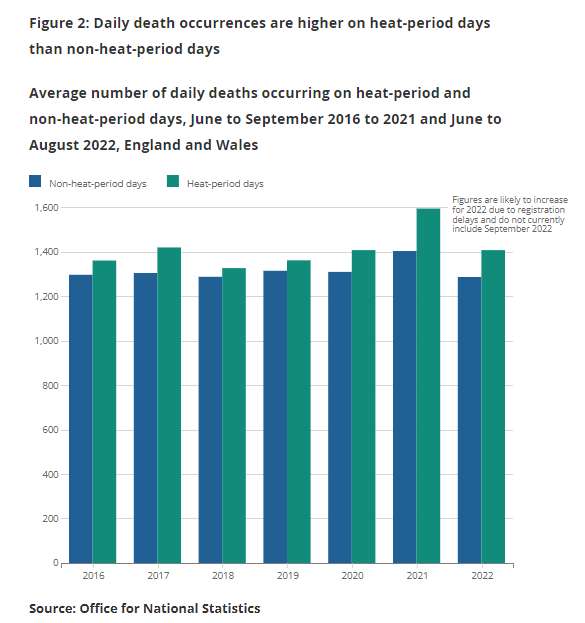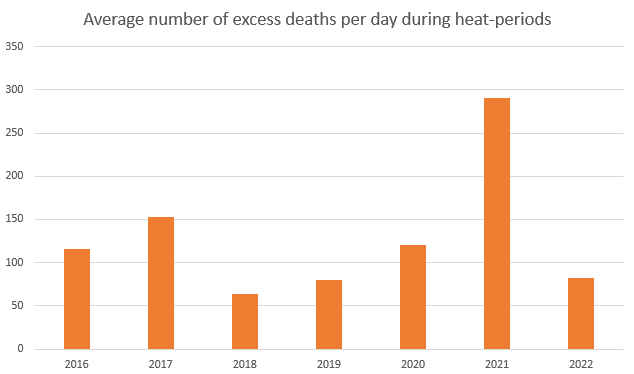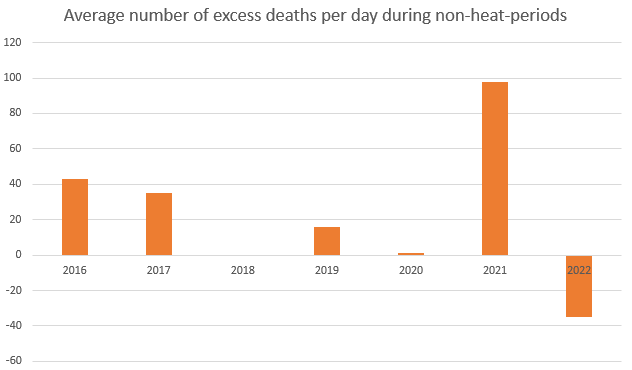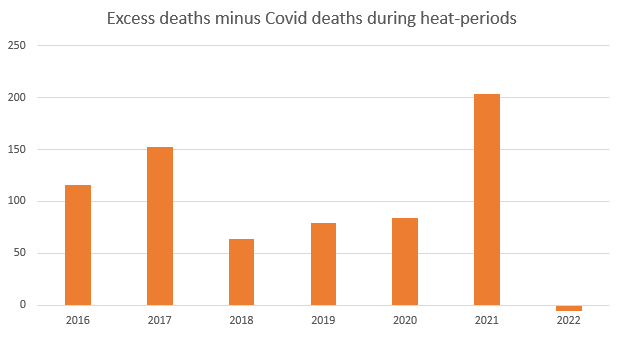The Office for National Statistics (ONS) in the UK, together with the UK Health Security Agency’s (UKHSA) Extreme Events department decided to look at excess mortality during heat-periods. There has been much hype over how hot it was this year so naturally they wanted to find out how many people died.
The Office for National Statistics ONS' Opinion survey, between 13 and 24 April, showed that over 6 in 10 adults in Great Britain think rising UK temperatures will affect them by 2030. This is why it is important to keep investigating the impact that climate change and rising temperatures has, including its impact on mortality.
According to the CCRA3 Technical report, the number of heat-related deaths in the UK could increase to 7,040 deaths per year by 2050.
A heat-period is defined as days when a Level 3 Heat Health Alert is issued or when the mean Central England temperature is greater than 20°C (68 F). I know, I know, over 20°C is unbearably hot, I’m surprised anyone still lives in the UK. So far in 2022 we have had five heat periods (I wish we’d had more, I prefer being warm).
The report concludes that there have been 3,271 excess deaths during heat-periods in 2022. This is 6.2% above the five-year average. They say that “prior to 2022, the most recent year with the highest observed mortality, as reported by the UKHSA, was 2020, when the total estimated excess mortality (excluding coronavirus (COIVD-19)) during heat periods in England was estimated to be 2,556 deaths.”
Strangely, they didn’t mention 2021.
Looking at one of their own graphs, 2021 sticks out like a sore thumb.
The graph, which looks at the average number of daily deaths on both heat-periods and non-heat periods, shows that 2021 was a bit of anomaly. During heat-periods, daily deaths were almost 15% higher than any of the previous peaks. Non-heat period daily deaths were up approximately 10%.
Climate change must have been really bad in 2021.
In fact, it wasn’t. There were only 12 heat-period days during 2021, compared with 40 in 2022.
In 2021, there were 3,483 excess deaths during 12 days of heat-periods compared with 3,271 over 40 days in 2022.
Looking at the average number of excess deaths per day, there were a staggering 290 excess deaths per day during heat-periods in 2021. Almost double the next highest peak in 2017.
But apparently this anomaly isn’t just the fault of climate change. Average excess deaths per day during non-heat periods (between June - September & June - August 2022) were also massively high.
There were 10,740 excess deaths over 110 non-heat-period days in 2021. The next highest was in 2016 when there were 4,521 excess deaths over 106 days.
Maybe these excess deaths were Covid deaths?
Even with Covid deaths removed, average number of excess deaths in 2021 is still much higher than normal.
This also provides us with a dilemma. If we remove Covid deaths to lower the 2021 figure then the 2022 figure goes negative, showing that an increased amount of heat-days didn’t kill anyone. Ahhhh it’s so tricky, climate change or nothing abnormal happening in 2021, I want to believe in both (I don’t).
To conclude, whilst the ONS were looking at excess deaths during heat-periods, what really jumps out is the anomalous amount of excess deaths during 2021. But on the topic of climate change, tucked away further down the report it says “Despite peaks in mortality during heat-periods, the majority of days in the winter period (December to March) show a higher number of deaths than during heat-periods”.
So whilst hot days may cause some excess deaths, cold days cause a lot more. But what happened in 2021? Strange.










Funny how people suddenly drop like flies when the temperature rises 2 degrees. But 99.999999999% of people that travel to visit, hike, camp, tour, and work in climates 20-30 degrees hotter than their homelands survive…
HOW DOES DUBAI HAVE ANY TOURISM?!!!!!!!!!!
The New Covid Playbook for Controlling the Masses is now being applied to Energy, Food and Climate. Here are the main tenets:
1. Own the Science
2. Flood the Zone
3. Wipe the internet
3. Incentivise compliance
4. Punish non-compliance
5. Amp the fear and leverage the Mass Formation
Look for these tactics from your friendly media moguls, government hacks and one world institutions